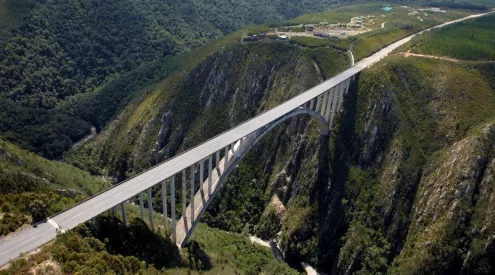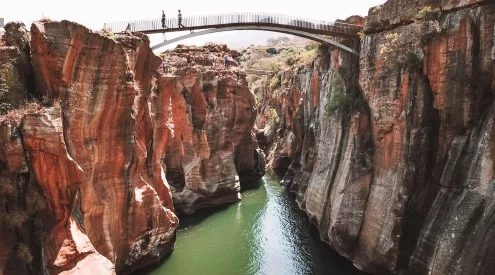‘So you want to see the secret cave?’ asked my partner Jason, nonchalantly motioning to a small, dark crack in the ground. I laughed out loud, thinking he was making a joke, but then the penny dropped. I stammered, ‘You mean you want me to crawl through … that … hole?’ It looked tiny and I couldn’t imagine it would lead to anything but a terrifying, bat-infested, spider-riddled death. ‘Ladies first,’ he smiled brightly. We were standing on a vertical cliff, one of the most distinguishing features of Arniston’s rugged limestone coastline which has been sculpted to the whim of the wind and the sea like playdough. Today it forms a series of dramatic arches, outcrops, overhangs and caves.
The most famous of these is called Waenhuiskrans, meaning ‘wagon house cliff’, because Dutch settlers believed it was big enough for an ox-wagon to turn around in. In today’s world perhaps a comparison to a double-cab Toyota Hilux would be more appropriate, but nonetheless, it is a rather large space.
It is submerged at high tide and pounded by incredible surf. Low tide reveals a small entrance, giving the intrepid a chance to steal a few moments in this uninhabitable space.
This is a place where the dark, dripping rocks inside contrast against the brightly lit and splashing turquoise outside – an experience that makes your heart beat with almost the same force as the crashing of the waves.
But now I was about to see another one of Arniston’s secrets, a lesser-known cave which might have served as shelter to the ancient strandlopers, or at the very least to a few jovial characters over a modern campfire in our more carefree age. Jason looked amused as I wedged myself into the hole, legs dangling, arms gripping, my feet searching for a landing. Small rocks dislodged and disappeard into the darkness beneath me. Finally I touched down and Jason scrambled in behind me. The cave was room-sized and offered a view over Arniston framed by its own ragged-edged eye. The rumbling of the waves as the sea heaved itself against the rocks below us sounded deep and powerful while the sight of birds gliding by just out of reach in the window of the cave’s opening formed a tranquil scene, all to the soundtrack of the whistling wind.We clambered out of the cave and made our way around the Nature Reserve. From the Struispunt Beacon, past ancient middens (heaps of ancient shells, bone and other artifacts discarded by Strandlopers from the Middle Stone Age… ) to the farthest reaches of the bay along a bumpy, muddy, sandy all-terrain road that eventually peeled away to reveal the windswept horizon, crashing surf, rocky coast and more of that turquoise water – Arniston offered up her little-known treasures from every vantage point.
Set against an aquamarine sea, the village Arniston is dotted with thatch-roofed white-washed cottages, the most famous ones forming the 200-year old Kassiesbaai, home to generations of villagers – in fact, the only people allowed to live there are the few that have been born there.
We wandered the paths between the historic buildings while curious children trailed behind us like we were part of the Pied Piper’s secret envoy. Recognized as a national monument, the sandstone fisherman’s’ cottages of Kassiesbai are bordered on one side by the town of Arniston and on the other side by a sea of sand dunes overlooking the site of the wreck of the HMS Arniston Transport.
One the worst nautical disasters of all time, 372 lives were lost and only six survived when this East Indiaman ship – which had until then survived pirate attacks and eight journeys between Great Britain and the Far East – sank unceremoniously in 1815. Apparently the owners of the ship didn’t put much stock into accurate navigation and decided it would be better to save a couple of bucks than to buy a marine chronometer, yesteryear’s GPS. Strong ocean currents led to one navigational error after the next, and eventually the Captain fatally headed north, running all 1468 tons aground over the L’Agulhas Reef just 900-metres from shore.
Today the ribs of the ship can be seen among the sand dunes, and fragments of its once proud brass-plated hull shine out in shades of weathered green to those who are lucky enough to find them. We headed in that direction in a 4×4 vehicle as the misty, ocean air began to stick to us, cold and clammy, as the sun began her descent.
The dunes rolled out before us like a Magic Carpet, undulating in the wind, while the waning light made it difficult to see where it rose and fell. Unphased, Jason kept up our speed as I held my breath, gripping both the roll-bar and my seat belt, a nervous smile permanently fixed on my face. ‘Wha-hoooooooo!’ I screamed convincingly, trying to to quell any thought that I might be in some sort of serious danger, out here in the sand dunes at dusk, as we seemed to freefall down 45-degree angles while Jason explained, nonchalantly of course, that this was much safer than driving along the ridge of the dune. ‘Oh, yes!’ I exclaimed, pink-cheeked and breathless, feeling more like a Yankee than ever.
We made it to the calmness of the beach where the waves had receded with the tide, leaving fields of seaweed strewn in big clumps like discarded piles of confetti. Non-plussed as usual, Jason simply drove over them. While I imagined long, multi-coloured sea-creature arms in deep shades of purple and green reaching up at the wheels like a living oceanic spider web, intent on trapping us or sweeping us out to sea, he kept an eye out for seashells.
Then Jason hit the brakes. Eagle-eyed he had spotted it – argonauta argo – a Paper Nautilus shell.
Prized among collectors, it is renowned for its wafer thin, spiralling beauty. It forms the shelter of the rare palagic octopus (one which lives in the open sea, not crawling along the seafloor like its lesser cousins) which also uses it for ingenious bouyancey control. Over the ages this very shell has been the subject of such consternation, even Aristotle hypothesized in 300BC that the shell was used as a boat, saying the octopus must surely rise to the surface and use its tentacles as oars and sails.
It must be noted that Aristotle had a rather wild imagination, but the theory so struck Jules Verne – who also had a wild imagination – that it inspired his Sailing Argonauts which he wrote about in Twenty Thousand Leagues Under the Sea.
Before long we had arrived. The history of the Arniston felt alive in this place by the sea – her weathered bits lay at rest between a view over the dunes on one side and a seaview over the town that shares the same name on the other. Yet what could have been a somber end to a thrilling day filled with historical intrigue and the beauty of nature’s creation suddenly turned lucky.
‘Hey, over here,’ called Jason, pointing to something in the white sand. I could see the luminuous green from where I stood, glowing in the setting sun. It was a piece of the Arniston’s brass plating, the tiniest of little shards. ‘It’s a piece of the Arniston, ‘ Jason offered, ‘for luck.’
Arniston is one of the best locations in South Africa to get to grips with your photography. Join world-renowned photographer and Master of Light, Art Wolfe, in Arniston for one of two four-day photography workshops. Book now, space is limited.
For accommodation in Arniston, try Getaway Accommodation for some wonderful options!


















